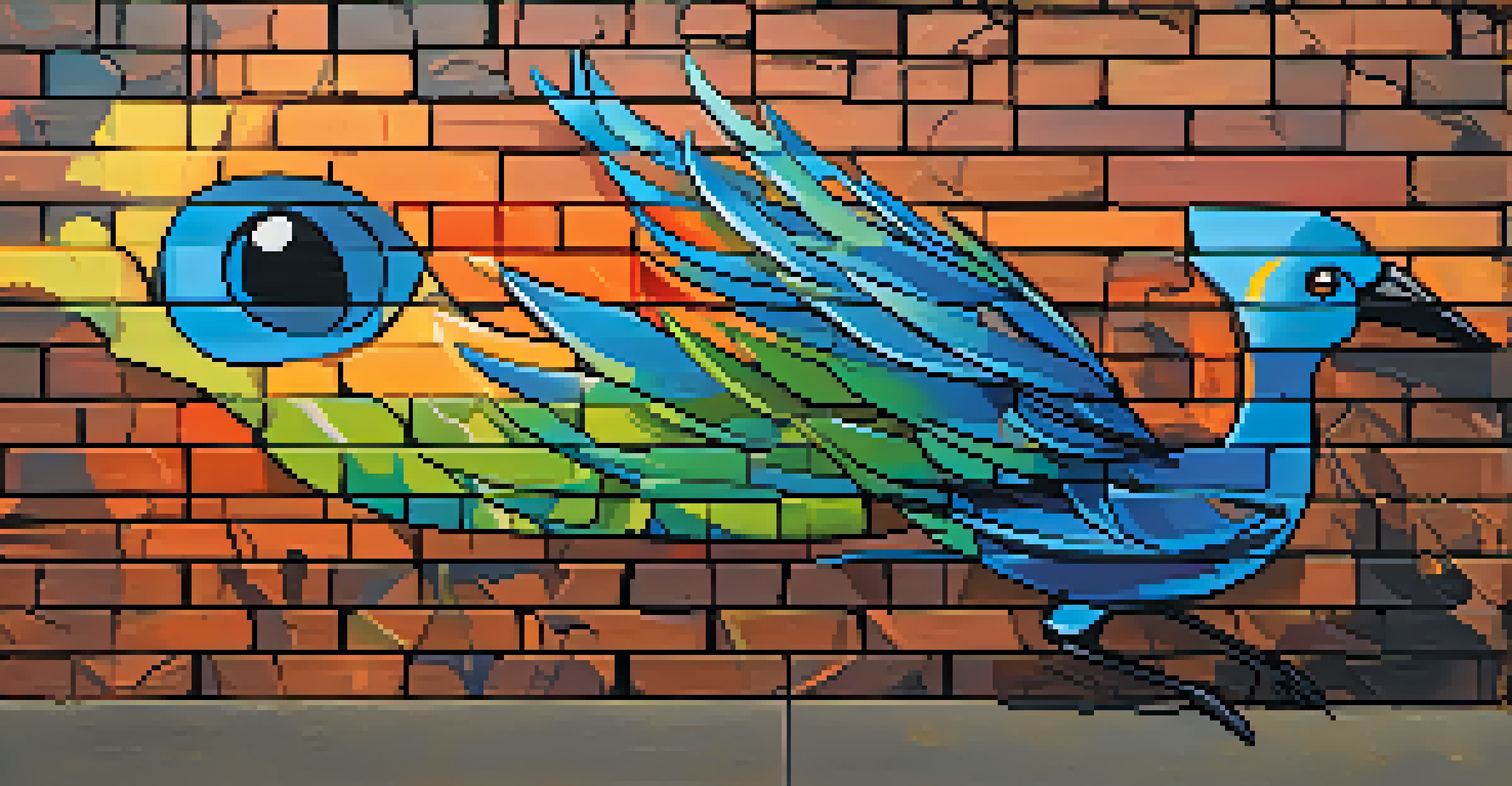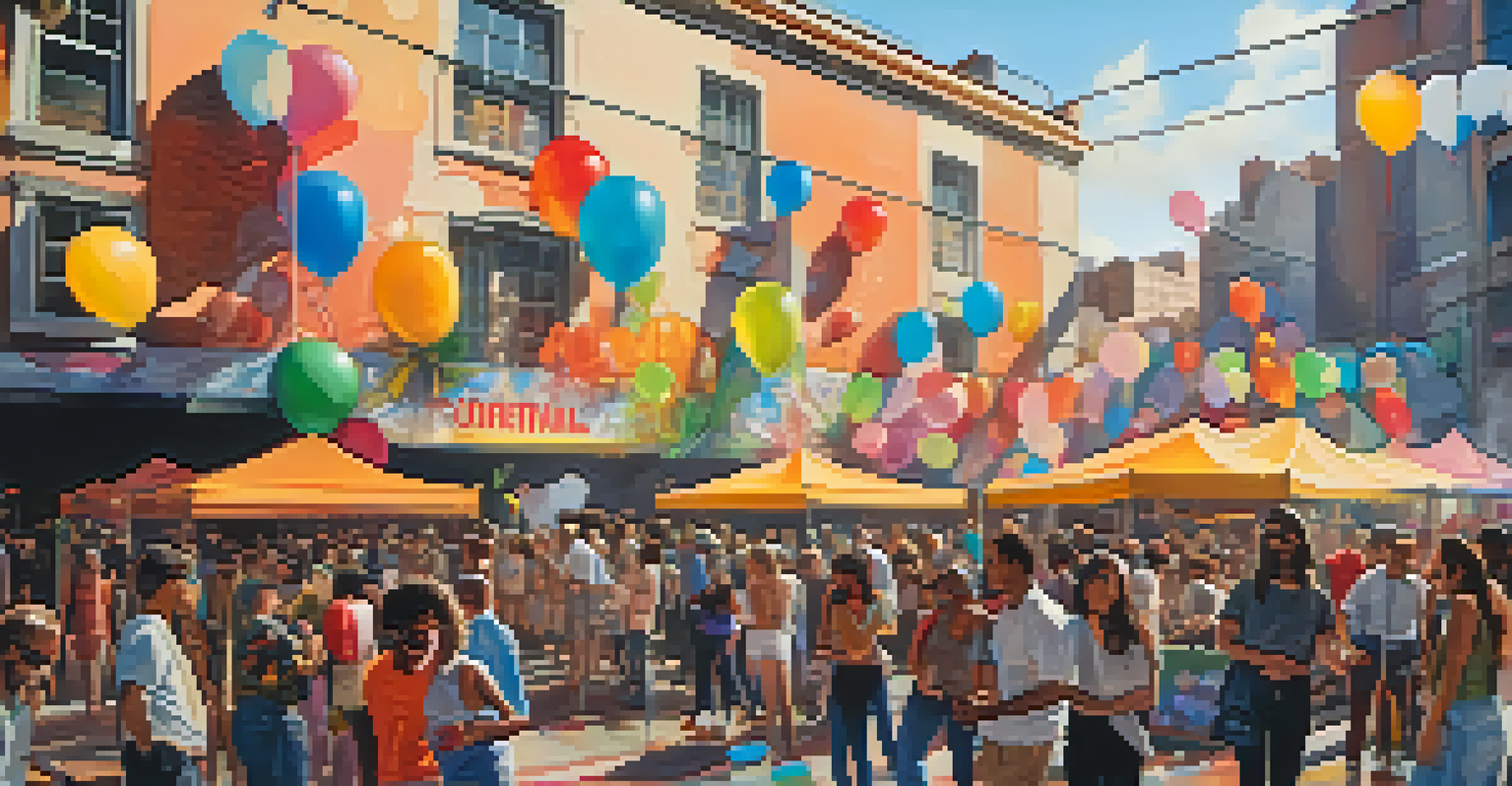The Evolution of Street Art: From Graffiti to Urban Gallery

The Roots of Street Art: Graffiti's Early Days
Street art's origins can be traced back to graffiti, which emerged in urban environments as a form of expression. Initially, it was often associated with rebellious youth and marginalized communities, who used walls as their canvas to voice discontent. This raw form of art created a dialogue about social issues, making it a powerful tool for those who felt unheard.
Art is not a mirror held up to reality, but a hammer with which to shape it.
In the 1970s and 80s, graffiti gained momentum, especially in cities like New York and Philadelphia. Artists began to develop their unique styles, using spray paint and stencils to create vibrant, eye-catching works. As they transformed dull cityscapes into colorful narratives, a culture of competition emerged, pushing artists to outdo each other in creativity and skill.
Despite its controversial beginnings, graffiti laid the groundwork for what would evolve into a broader street art movement. It challenged societal norms and expectations about art, prompting discussions about public space and artistic legitimacy. This early phase set the stage for street art to evolve into a recognized form of cultural expression.
The 1980s and 90s: From Vandalism to Recognition
As street art gained popularity, it began to attract attention from the mainstream art world. In the 1980s and 90s, galleries started showcasing works by graffiti artists, bridging the gap between street art and traditional art forms. This shift marked a turning point, as artists like Jean-Michel Basquiat and Keith Haring emerged from the streets to exhibit in prestigious spaces.

The increased visibility of street art also led to a growing debate about its legitimacy. While some viewed it as vandalism, others recognized its potential to beautify urban spaces and convey powerful messages. This tension fueled discussions about what constitutes art and who gets to define it, paving the way for a more inclusive understanding of creative expression.
Street Art's Evolution and Impact
Street art has transformed from graffiti associated with rebellion to a recognized form of cultural expression that addresses social issues.
During this time, street art began to diversify, with artists experimenting with various mediums and styles. Murals, stencils, and paste-ups became common, allowing for new narratives to emerge. This period of experimentation laid the foundation for the more complex and varied forms of street art we see today.
The Rise of Street Art Festivals and Community Engagement
The early 2000s witnessed a surge in street art festivals, which celebrated this vibrant form of expression and encouraged community involvement. Events like the Mural Festival in Montreal and Pow! Wow! in Hawaii brought together local and international artists, transforming neighborhoods into open-air galleries. These festivals not only showcased talent but also fostered a sense of community pride.
Street art is a form of activism that gives a voice to the unheard.
Through collaborative projects, artists worked alongside residents to beautify their neighborhoods, turning once-neglected spaces into areas of inspiration. This engagement highlighted the power of art to create social change, as communities came together to address local issues through visual storytelling. The impact of these initiatives extended beyond aesthetics, promoting dialogue and unity.
As street art festivals gained popularity, they also attracted tourists and art enthusiasts, further legitimizing street art as a significant cultural phenomenon. This recognition encouraged cities to embrace street art as a vital part of their identity, leading to more murals and public art installations that reflect local culture and history.
The Role of Technology in Shaping Street Art
Technology has played a crucial role in the evolution of street art, from the rise of social media to the advent of digital tools. Platforms like Instagram and Pinterest have allowed artists to showcase their work to a global audience, creating new opportunities for exposure and collaboration. This shift has transformed how artists promote themselves and connect with fans.
Moreover, technology has enabled artists to experiment with new techniques and mediums. Digital design software allows for intricate planning and execution, while augmented reality (AR) brings street art to life in innovative ways. These advancements challenge traditional notions of street art, expanding the boundaries of what is possible and encouraging fresh ideas.
Technology's Role in Street Art
Advancements in technology, especially social media and digital tools, have expanded the reach and creativity of street artists worldwide.
As a result, street art has become more accessible, with artists from diverse backgrounds sharing their stories and perspectives. This democratization of art encourages a more inclusive dialogue about creativity and expression, allowing for a richer tapestry of voices within the street art community.
Street Art as a Tool for Activism and Social Change
Street art has increasingly become a powerful tool for activism, allowing artists to address pressing social issues and inspire change. Many artists use their work to highlight topics such as inequality, environmentalism, and political unrest, creating visual commentary that resonates with audiences. This ability to provoke thought and dialogue is one of the defining features of contemporary street art.
For example, the rise of murals depicting social justice themes has sparked conversations around racial equality and LGBTQ+ rights. These artworks not only beautify urban landscapes but also serve as reminders of ongoing struggles and the need for solidarity. By using public spaces as their canvas, artists can reach broader audiences, making their messages more impactful.
As street art continues to evolve, its role in activism will likely grow. Artists are increasingly collaborating with organizations and communities to create works that reflect collective experiences and aspirations. This synergy between art and activism fosters a sense of agency, empowering individuals to engage with their environment and advocate for change.
Globalization and the Spread of Street Art
The globalization of street art has led to a rich exchange of styles and ideas, as artists from different cultures share their perspectives. This cross-pollination results in unique artworks that reflect local traditions while incorporating global influences. As street art moves across borders, it creates a tapestry of creative expressions that speak to shared human experiences.
Cities around the world have embraced street art, transforming their urban landscapes into vibrant cultural hubs. From the colorful murals of Buenos Aires to the intricate stencils of Berlin, each city's street art scene tells a story about its people and history. This diversity enriches the global conversation, showcasing the power of art to transcend language and cultural barriers.
Street Art as Activism
Contemporary street art increasingly serves as a powerful tool for activism, tackling pressing social issues and inspiring community engagement.
However, globalization also presents challenges, including issues of commodification and cultural appropriation. As street art becomes more commercialized, artists must navigate the fine line between maintaining authenticity and appealing to a wider audience. This ongoing dialogue highlights the complexities of street art in a globalized world, where local voices must be respected and celebrated.
The Future of Street Art: Trends and Innovations
As we look to the future, it's clear that street art will continue to evolve, driven by emerging trends and innovations. One significant trend is the rise of interactive and immersive experiences, where viewers can engage with art in new and meaningful ways. These installations invite audiences to participate, fostering a deeper connection between the artwork and the viewer.
Additionally, the fusion of street art with technology will likely shape its future. Artists may increasingly use virtual reality (VR) and digital projections to create dynamic, ever-changing pieces that challenge traditional notions of permanence. This evolution allows for greater experimentation, pushing the boundaries of what street art can be.

Ultimately, the future of street art lies in its ability to adapt and respond to societal changes. As new voices emerge and issues evolve, street art will continue to serve as a platform for expression, dialogue, and transformation. This adaptability ensures that street art remains a vital and relevant part of contemporary culture.